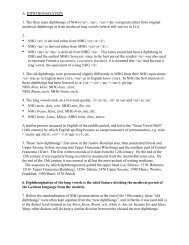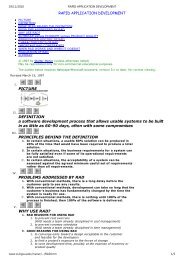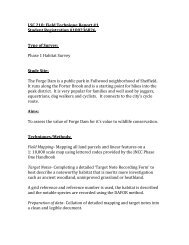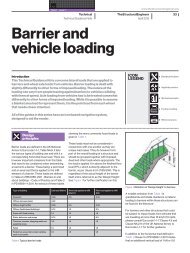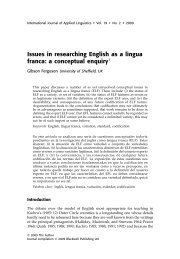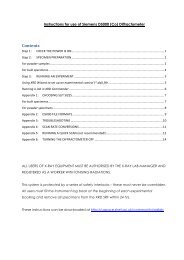A guideline for the design of a four-wheeled walker.pdf
A guideline for the design of a four-wheeled walker.pdf
A guideline for the design of a four-wheeled walker.pdf
Create successful ePaper yourself
Turn your PDF publications into a flip-book with our unique Google optimized e-Paper software.
Downloaded by [University <strong>of</strong> Sheffield] at 14:02 15 February 2012<br />
where a is <strong>the</strong> acceleration <strong>of</strong> <strong>the</strong> wheel. All variables<br />
are known except this acceleration. Isolating<br />
<strong>for</strong> <strong>the</strong> acceleration,<br />
a = A y - WAz/w/2g. (8)<br />
For uni<strong>for</strong>m acceleration (a = const.) over a small<br />
interval <strong>of</strong> time t,<br />
For <strong>the</strong> case <strong>of</strong><strong>the</strong> wheel not contacting <strong>the</strong> ground<br />
(Fz = 0),<br />
Converging on a Design Parameter<br />
(9)<br />
where d, is an incremental distance slid over a<br />
small interval <strong>of</strong> time. Assuming V o = 0 over this<br />
short time span with constant acceleration,<br />
r, = w/ zg 'a<br />
a = Fylw/2g'<br />
(10)<br />
(11)<br />
(12)<br />
Once acceleration is determined, <strong>the</strong> distance can<br />
be calculated. The distance that <strong>the</strong> mass moves<br />
between each data point can <strong>the</strong>n be summed <strong>for</strong><br />
<strong>the</strong> total slide distance. Dangerous sliding can occur<br />
at ei<strong>the</strong>r <strong>of</strong> <strong>the</strong> braked wheels at two points<br />
during <strong>the</strong> trial, sitting down and <strong>the</strong>n standing<br />
up. The maximum <strong>of</strong> <strong>the</strong>se <strong>four</strong> sliding distances<br />
was set to 5 em. This distance is large enough not<br />
to demand extreme <strong>walker</strong> <strong>design</strong>s, yet small<br />
enough not to cause stress to <strong>the</strong> user while sitting.<br />
The above calculations can be used to find <strong>the</strong><br />
relationship between any two variables if<strong>the</strong> o<strong>the</strong>r<br />
five are known. For example, if <strong>the</strong> effect <strong>of</strong> <strong>the</strong><br />
seat position on <strong>the</strong> required <strong>walker</strong> mass must be<br />
determined, all o<strong>the</strong>r variables are held constant,<br />
and an iterative procedure can be per<strong>for</strong>med <strong>for</strong><br />
each <strong>walker</strong> mass to isolate <strong>the</strong> seat position that<br />
will allow <strong>for</strong> <strong>the</strong> desired maximum sliding distance.<br />
Any seat position behind this value will be<br />
a safe <strong>design</strong> with respect to sliding, while positions<br />
fur<strong>the</strong>r to <strong>the</strong> front will cause excessive sliding.<br />
The bisection method was used to converge on<br />
desired values to within 5%.<br />
Tipping<br />
Ifat any time <strong>the</strong> applied <strong>for</strong>ce vector and <strong>walker</strong><br />
weight combine <strong>for</strong> a resultant <strong>for</strong>ce outside <strong>of</strong><br />
<strong>the</strong> wheelbase, <strong>the</strong> wheels will begin to rise <strong>of</strong>f<strong>the</strong><br />
ground. The only opposing <strong>for</strong>ce that will help to<br />
maintain <strong>the</strong> stability <strong>of</strong> <strong>the</strong> <strong>walker</strong> is <strong>the</strong> <strong>walker</strong><br />
weight. As long as <strong>the</strong> resultant <strong>of</strong> <strong>the</strong> combined<br />
<strong>walker</strong> weight Wand applied <strong>for</strong>ce F are contained<br />
within <strong>the</strong> wheelbase, tipping will be avoided. Five<br />
<strong>of</strong><strong>the</strong> <strong>design</strong> variables affect tipping: seat position,<br />
wheelbase, <strong>walker</strong> mass, center <strong>of</strong> gravity, and<br />
configuration. For example, a larger wheel base reduces<br />
<strong>the</strong> tipping moment caused by <strong>the</strong> <strong>for</strong>ces applied<br />
outside <strong>of</strong> <strong>the</strong> wheelbase by shortening <strong>the</strong><br />
distances that <strong>the</strong>y are acting from <strong>the</strong> wheels. The<br />
position <strong>of</strong> <strong>the</strong> center <strong>of</strong> gravity <strong>of</strong> <strong>the</strong> <strong>walker</strong> will<br />
control how great a stabilizing moment <strong>the</strong> <strong>walker</strong><br />
weight will cause about <strong>the</strong> wheels. Moment calculations<br />
were per<strong>for</strong>med to estimate <strong>design</strong> variables<br />
that would allow <strong>for</strong> a 2-cm rise <strong>of</strong> ei<strong>the</strong>r <strong>the</strong><br />
braked wheels or <strong>the</strong> casters.<br />
Brake Failure<br />
Brake failure can occur only when <strong>the</strong>re is<br />
enough normal <strong>for</strong>ce acting through <strong>the</strong> braked<br />
wheels to avoid sliding. If <strong>the</strong> shear (horizontal)<br />
<strong>for</strong>ce applied to ei<strong>the</strong>r <strong>of</strong><strong>the</strong> braked wheels creates<br />
enough <strong>of</strong> a shear stress at <strong>the</strong> brake pad to exceed<br />
<strong>the</strong> grip <strong>of</strong> <strong>the</strong> brake on <strong>the</strong> tire, <strong>the</strong> wheels will<br />
roll. As in sliding, small movements <strong>of</strong> <strong>the</strong> <strong>walker</strong><br />
will go unnoticed by <strong>the</strong> user. Figure B6 shows <strong>the</strong><br />
shear <strong>for</strong>ce applied by <strong>the</strong> user through one braked<br />
wheel over an entire trial. The horizontal line represents<br />
<strong>the</strong> shear that <strong>the</strong> brake can withstand<br />
without allowing rolling. The portion <strong>of</strong> <strong>the</strong> curve<br />
above this line indicates rolling. The maximum<br />
shear <strong>for</strong>ce that allows less than 5 em (2 in.) <strong>of</strong> rolling<br />
must be found to avoid significant brake failure.<br />
Design variables that will affect brake failure<br />
are <strong>the</strong> seat-handle configuration and <strong>the</strong> <strong>walker</strong><br />
mass. As <strong>the</strong> <strong>walker</strong> mass increases, <strong>the</strong>re is a<br />
greater load to accelerate, resulting in less movement.<br />
Calculations similar to <strong>the</strong> sliding analysis<br />
were <strong>the</strong>n per<strong>for</strong>med to estimate <strong>design</strong> variables<br />
that would allow <strong>for</strong> a 5-cm roll <strong>of</strong> ei<strong>the</strong>r <strong>of</strong> <strong>the</strong><br />
braked wheels.<br />
GUIDELINE FOR WALKER DESIGN 129



